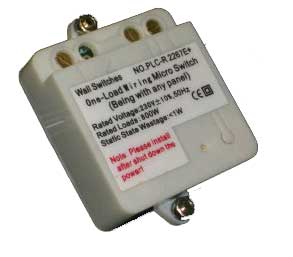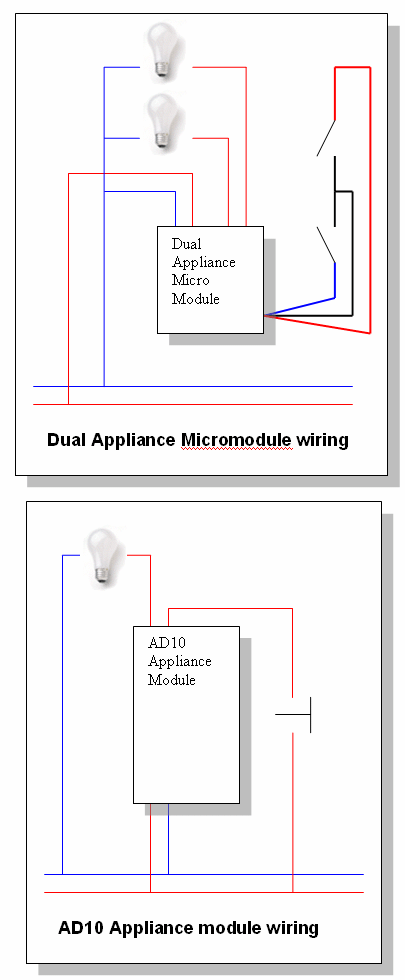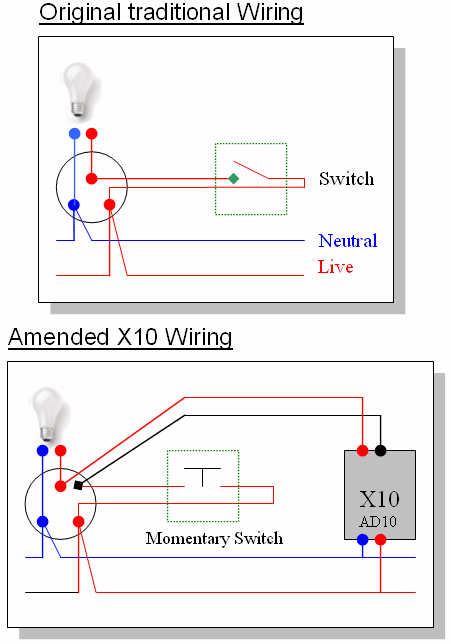
Submission by Marcus Warrington – A few weeks ago, on the UKHA email list , we were discussing the X10^2 Micromodules that are available from Kevin Lo in Hong Kong (via eBay). There was some discussion over their ability to be used with latched and momentary switches, with the outcome being that they did work with momentary switches.
The modules were ordered via Kevin’s shop on eBay, and arrived 2 days later .. wow, 2days from Hong Kong to the UK that’s quicker than some of own our domestic post! They attracted no import duty or VAT so the final cost was just the £24.99 per unit plus £6.99 postage.
The module has two grub screw style connections along the top for Live and Neutral feeds, together with a further two screws for connecting switched live to Appliance1 and Appliance2. There are also three short wires, Red, Blue and Black that emerge from the rear of the module casing. By shorting Red to Black or Blue to Black Appliance 1 and 2 can be switched. These wires are about 5 inches long and LOW VOLTAGE only, being powered internally by the module. They should NOT be connected to the mains Live (or Neutral) like a standard LD11 or AD10, which uses high voltage to detect the switch state.


Now, onto the problem I mentioned earlier. The switch would work fine when connected to a normal latching style switch but not when connected to a momentary style switch. After much head scratching and cursing I emailed Kevin Lo, who contacted his R&D department. After couple of days Kevin got back to me with the bad news… the dual appliance modules do NOT work with momentary switches. This is despite the manual saying that they do.
The single appliance modules DO work with momentary switches.. but only with “Normally Closed” style switches and a bit of reconfiguration of the wiring.
- Install the One Load Appliance Micro Module at Ceiling ( or near the Lamp )
- Connect Hole 1 to Lamp – Connect Hole ‘N’ connect the Neutral Wire – Connect Hole ‘L’ connect the Wire from Wall Switch
- Install the Normal Close Momentary Wall Switch at the back box – Connect one hole to the Live Wire – Connect the other hole to the wire going to the Micro Module (That means use the Momentary Wall Switch to control the power supply to Micro Module)
- Press the setup button to put the Micro Module in “Setup” mode
- Send X10 “Bright” Command – this puts the module into momentary switch mode
So if the Micro Module is ON and you now press the Momentary Wall Switch , it cut the power momentarily to the Micro Module and it will turn OFF. If the micro module is OFF and you press the Momentary Wall Switch again the micro module will turn ON
Throughout all this investigation Kevin’s customer support has been absolutely fantastic and having now established how these modules work and that they are not suitable for my application he has issued a full refund (including all postage costs).
If, given the above info, the modules ARE suitable for you then I have absolutely no problem fully recommending Kevin as a supplier.
Pros
- Tiny size
- Barely audible relay.
- Two appliances modules in one unit
- Excellent signal to noise ratio
- Cheap!
- Excellent customer service
- Low voltage switching wires*
Cons
- No manual setup, have to program electronically requiring a transmitter
- Low voltage switching wires*
- No momentary switches, only latching style (on dual modules)
- Requires a neutral connection

Be the first to comment on "X10-2 Micro Appliance Modules – Review"